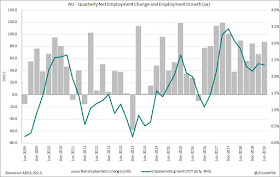Labour Force Survey — June | By the numbers
- Employment increased by a net 500 in seasonally adjusted terms; well below the median forecast for a rise of 9,000. May's initially reported increase of 42,300 was revised up to 45,300.
- The national unemployment rate was unchanged at 5.2%, in line with the consensus forecast.
- The underemployment rate fell from 8.6% to 8.2%, while the underutilisation rate improved from 13.7% to 13.4%.
- The participation rate remained at its record high achieved in the previous month at 66.0%, whereas it had been anticipated to ease to 65.9%.
- Aggregate hours worked were flat in the month at 1.77bn hours, stabilising after declines in April and May, as annual growth fell from 2.1% to 1.6%.
Labour Force Survey — June | The details
As highlighted in our preview, employment was expected to moderate in June, in part because statistical volatility looked to have helped drive the very strong gains seen in April and May, and that was not expected to be repeated on this occasion. That expectation was broadly vindicated, though the moderation occurred at a more rapid pace. The net increase of 500 jobs was the weakest outturn since July last year and was split between a 21,100 rise from full-time work and a 20,600 fall in part-time positions. These outcomes saw the annual pace of total employment growth slow from 2.9% to 2.4%, with full-time easing from 3.1% to 2.9% and the more volatile part-time segment halving from 2.4% to 1.2%.
For Q2, net employment lifted by 87,700, its strongest quarterly gain in a year, while the annual pace of employment growth was in line with where it was at the end of the March quarter.
At two decimal places, the unemployment rate lifted from 5.19% to 5.24%. That occurred because the net increase in employment of 500 fell well short of meeting the addition of around 7,000 new entrants into the workforce.
Notwithstanding, the underutilisation rate (including the unemployed and those workers who want and are able to work more hours) fell from 13.75% to 13.43%, while the underemployment rate (those employed who want and are able to work more hours) declined from 8.55% to 8.19%. The underemployment rate is a critical measure the Reserve Bank of Australia looks at to determine the level of spare capacity in the labour market, as it highlighted in its July meeting minutes that were released earlier this week.
These improvements in underutilisation reference a better outcome from hours worked on this occasion. Following back-to-back declines, aggregate hours worked steadied in June at 1.77bn hours, though the annual pace (which is volatile) fell from 2.1% to 1.6%. After adjusting for the modest increase to employment, average hours worked per employee remained at 137.8 hours. This followed declines of 0.5% in April and 0.7% in May. However, the through-the-year pace was unchanged at -0.7%.
Turning to the state details, there was little positive news to report given that only one state, Western Australia, saw its unemployment rate decline. The details for June were (change across Q2 in brackets); New South Wales held at 4.6% (+0.2ppt), Victoria +0.2ppt to 4.8% (+0.2ppt), Queensland +0.3ppt to 6.5% (+0.4ppt), South Australia +0.2ppt to 5.9% (steady), Western Australia -0.4ppt to 5.8% (-0.2ppt), and Tasmania +0.4ppt to 6.8% (+0.1ppt).
The next chart shows the net employment outcomes from each state on a monthly (lower bars), quarterly (middle bars) and annual (upper bars) basis.
Labour Force Survey — June | Insights
Employment moderated sharply in June, but that followed very strong outcomes in April and May. Overall, Q2 was fairly robust in terms of employment growth at 87, 700 and was a notable improvement on Q1's total of 67,400. For some time, though, the forward-looking indicators for labour demand in private surveys and advertisements have indicated that employment growth is likely to slow. To support employment growth against those headwinds, the RBA delivered consecutive rate cuts in June and July. The minutes from July's meeting confirmed that the Board would continue its close focus on the labour market, in which the key indicators are the unemployment and underemployment rates and wages growth, and is prepared to deliver further easing "if needed".








